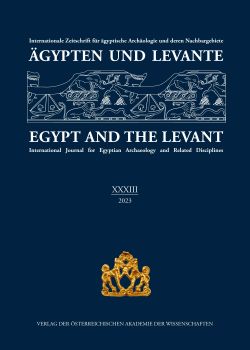Manfred BIETAK (Editor in Chief) - Ernst Czerny - Christiana Köhler - Nadine Moeller - Karol Myśliwiec (Eds.)
Ägypten und Levante XXXIII
Egypt and the Levant XXXIII
Internationale Zeitschrift für ägyptische Archäologie und deren Nachbargebiete
International Journal for Egyptian Archaeology and Related Disciplines
Francesco Ignazio De Magistris
S. 235 - 254
doi:
10.1553/AEundL33s235
Verlag der Österreichischen Akademie der Wissenschaften
doi:
10.1553/AEundL33s235
Abstract:
Alan Gardiner was the first to reconstruct and review the written sources regarding the so-called “Ways of Horus”, a chain of fortresses established in North Sinai during the New Kingdom. To this day, his 1920 article “The Ancient Military Road between Egypt and Palestine” is the stepping stone and the starting point for every discussion on the argument. The article’s enduring importance is connected not only to the fact that Gardiner convincingly connected the 12-forts description contained in Papyrus Anastasi I with the depiction present in the Karnak Reliefs of Seti I; and that he reconstructed the deteriorated (and deteriorating) reliefs on the base of copies made during the 19th-century. His 11-forts reconstruction of the reliefs has been used by virtually every scholar ever since. However, reconciling the discrepancies between the two documents, particularly regarding the number of forts, has proven to be an unsolvable problem. This article demonstrates that a twelfth fort – originally present in the Karnak Reliefs – went unnoticed by Gardiner. It shows that Ippolito Rosellini depicted it in a copy of the Reliefs made in 1829, and that he described it in his notes. It highlights that the University of Chicago’s Epigraphic Survey of the Reliefs found traces of the name of the fort’s accompanying well. It finally reassesses the subject of the so-called “Ways of Horus” and, by recognizing the existence of this “ forgotten fort”, supports Alan Gardiner’s century old argument that the description in Papyrus Anastasi I aligns with the depiction in the Karnak Reliefs.
Ways of Horus; Karnak reliefs; Papyrus Anastasi I; North Sinai; Gardiner
Published Online:
2024/02/28 15:31:11
Object Identifier:
0xc1aa5576 0x003ed9c8
Rights:All rights reserved.For questions regarding copyright and copies please contact us by email.
Die Zeitschrift Ägypten und Levante wurde im Jahr 1990 von Manfred Bietak begründet, um den Forschungen zu den Kulturkontakten zwischen Ägypten und seinen Nachbarländern sowie der ägyptisch-kanaanäischen Hybridkultur, wie sie vor allem bei den österreichischen Ausgrabungen in Tell el-Dab’a zutage trat, eine Publikationsplattform zu bieten. Von Anfang an war die Zeitschrift international und interdisziplinär ausgerichtet. Das Themenfeld geht über die ursprüngliche Kernthematik weit hinaus und umfasst sowohl Vorberichte und Berichte zu archäologischen Grabungen in Ägypten und dem gesamten Vorderen Orient sowie Nubien und dem Sudan, wie auch Artikel zu allen Aspekten der ägyptischen und nahöstlichen Archäologie, Geschichts- und Kulturwissenschaft. Der Fokus liegt auf der pharaonischen Zeit, jedoch sind sowohl Beiträge zur Ur- und Frühgeschichte der genannten Regionen wie auch zur nachpharaonischen Antike möglich. Dazu wird ein weites Feld an naturwissenschaftlichen Themen abgedeckt, von Fragen der C14-Datierung über materialkundliche Untersuchungen bis hin zu archäobotanischen, archäozoologischen und anthropologischen Arbeiten.
Ägypten und Levante erscheint einmal jährlich im Druck und online. Die Redaktion ist bemüht, eingereichte Artikel möglichst zeitnah zu publizieren. Beiträge sind in Deutsch, Englisch oder Französisch einzureichen. Buchbesprechungen und Rezensionen werden nicht publiziert. Alle eingereichten Artikel werden einem internationalen peer-review Verfahren gemäß den Qualitätsstandards der Österreichischen Akademie der Wissenschaften unterzogen.
Egypt and the Levant was founded by Manfred Bietak in 1990 to provide a publication platform for the research on cultural contacts between Egypt and her neighbours. A focus of interest was the Egyptian-Canaanite fusion of cultures, which was mainly encountered at the site of Tell el-Dab’a during the Austrian excavations. From the beginning, the scope of the journal was international and interdisciplinary. The subject area has now been greatly expanded far beyond the original topics. It comprises reports and preliminary reports on archaeological excavations in Egypt and the entire Middle East including the Sudan, as well as articles dealing with all aspects of Egyptian and Near Eastern archaeology, history or cultural history. The main emphasis lays on the pharaonic period, but both contributions to prehistory of the said regions, and post-pharaonic periods may be accepted. In addition, a broad range of scientific topics is covered, including C14-dating, material analyses, archaeobotanical and archaeozoological studies as well as studies in physical anthropology.
Egypt and the Levant is published on an annual basis, both in print and online. Submitted articles are intended to be published in a timely manner. Manuscripts may be submitted in English, German or French. Book reviews are not accepted. All submitted articles are subject to international peer-review according to quality standards of the Austrian Academy of Sciences.



 Home
Home Print
Print
 References
References
 Share
Share
